New CCNA – RSTP
Note: If you are not sure about Rapid Spanning Tree Protocol, please read our Rapid Spanning Tree Protocol RSTP Tutorial.
Question 1
Which three statements about RSTP are true? (Choose three)
A. RSTP significantly reduces topology reconvening time after a link failure.
B. RSTP expands the STP port roles by adding the alternate and backup roles.
C. RSTP port states are blocking, discarding, learning, or forwarding.
D. RSTP provides a faster transition to the forwarding state on point-to-point links than STP does.
E. RSTP also uses the STP proposal-agreement sequence.
F. RSTP uses the same timer-based process as STP on point-to-point links.
Answer: A B D
Question 2
Refer to the exhibit:
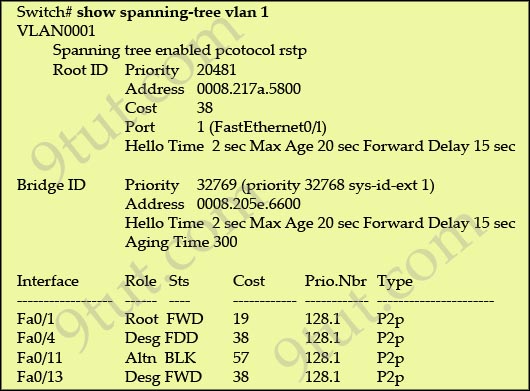
Why has this switch not been elected the root bridge for VLAN1?
A. It has more than one internee that is connected to the root network segment.
B. It is running RSTP while the elected root bridge is running 802.1d spanning tree.
C. It has a higher MAC address than the elected root bridge.
D. It has a higher bridge ID than the elected root bridge.
Answer: D
Explanation
As we can see from the output above, the priority of the root bridge is 20481 while that of the local bridge is 32769.
Question 3
Which command enables RSTP on a switch?
A. spanning-tree mode rapid-pvst
B. spanning-tree uplinkfast
C. spanning-tree backbonefast
D. spanning-tree mode mst
Answer: A
Question 4
Refer to the exhibit. Which statement is true?
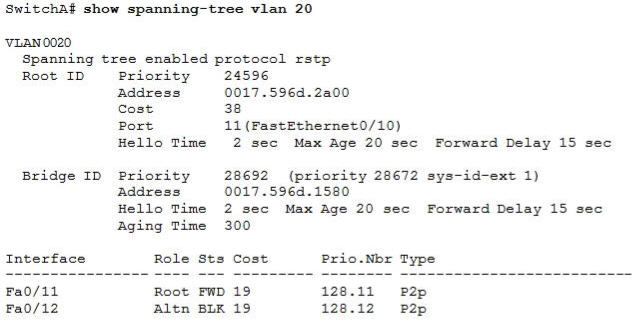
A. The Fa0/11 role confirms that SwitchA is the root bridge for VLAN 20.
B. VLAN 20 is running the Per VLAN Spanning Tree Protocol.
C. The MAC address of the root bridge is 0017.596d.1580.
D. SwitchA is not the root bridge, because not all of the interface roles are designated.
Answer: D
Explanation
Only non-root bridge can have root port. Fa0/11 is the root port so we can confirm this switch is not the root bridge -> A is not correct.
From the output we learn this switch is running Rapid STP, not PVST -> B is not correct.
0017.596d.1580 is the MAC address of this switch, not of the root bridge. The MAC address of the root bridge is 0017.596d.2a00 -> C is not correct.
All of the interface roles of the root bridge are designated. SwitchA has one Root port and 1 Alternative port so it is not the root bridge -> D is correct.
Question 5
Refer to the exhibit. The output that is shown is generated at a switch. Which three of these statements are true? (Choose three)
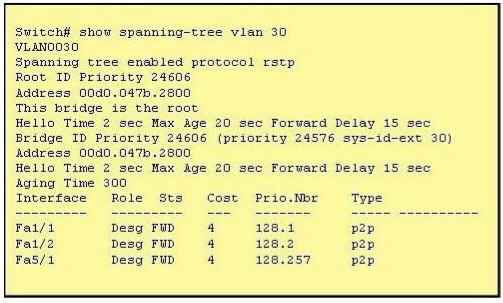
A. All ports will be in a state of discarding, learning or forwarding.
B. Thirty VLANs have been configured on this switch.
C. The bridge priority is lower than the default value for spanning tree.
D. All interfaces that are shown are on shared media.
E. All designated ports are in a forwarding state.
F. The switch must be the root bridge for all VLANs on this switch.
Answer: A C E
Explanation
From the output, we see that all ports are in Designated role (forwarding state) -> A and E are correct.
The command “show spanning-tree vlan 30″ only shows us information about VLAN 30. We don’t know how many VLAN exists in this switch -> B is not correct.
The bridge priority of this switch is 24606 which is lower than the default value bridge priority 32768 -> C is correct.
All three interfaces on this switch have the connection type “p2p”, which means Point-to-point environment – not a shared media -> D is not correct.
The only thing we can specify is this switch is the root bridge for VLAN 3o but we can not guarantee it is also the root bridge for other VLANs -> F is not correct.
Question 6
Which two states are the port states when RSTP has converged? (choose two)
A. blocking
B. learning
C. disabled
D. forwarding
E. listening
Answer: A D
Explanation
RSTP only has 3 port states that are discarding, learning and forwarding. When RSTP has converged there are only 2 port states left: discarding and forwarding but the answers don’t mention about discarding state so blocking state (answer A) may be considered the best alternative answer.
Question 7
Which two of these statements regarding RSTP are correct? (Choose two)
A. RSTP cannot operate with PVST+.
B. RSTP defines new port roles.
C. RSTP defines no new port states.
D. RSTP is a proprietary implementation of IEEE 802.1D STP.
E. RSTP is compatible with the original IEEE 802.1D STP.
Answer: B E
Question 8
Refer to the exhibit. Each of these four switches has been configured with a hostname, as well as being configured to run RSTP. No other configuration changes have been made. Which three of these show the correct RSTP port roles for the indicated switches and interfaces? (Choose three)
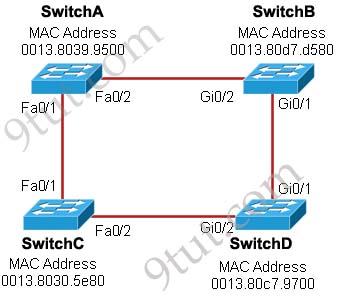
A. SwitchA, Fa0/2, designated
B. SwitchA, Fa0/1, root
C. SwitchB, Gi0/2, root
D. SwitchB, Gi0/1, designated
E. SwitchC, Fa0/2, root
F. SwitchD, Gi0/2, root
Answer: A B F
Explanation
The question says “no other configuration changes have been made” so we can understand these switches have the same bridge priority. Switch C has lowest MAC address so it will become root bridge and 2 of its ports (Fa0/1 & Fa0/2) will be designated ports -> E is incorrect.
Because SwitchC is the root bridge so the 2 ports nearest SwitchC on SwitchA (Fa0/1) and SwitchD (Gi0/2) will be root ports -> B and F are correct.
Now we come to the most difficult part of this question: SwitchB must have a root port so which port will it choose? To answer this question we need to know about STP cost and port cost.
In general, “cost” is calculated based on bandwidth of the link. The higher the bandwidth on a link, the lower the value of its cost. Below are the cost values you should memorize:
| Link speed | Cost |
| 10Mbps | 100 |
| 100Mbps | 19 |
| 1 Gbps | 4 |
SwitchB will choose the interface with lower cost to the root bridge as the root port so we must calculate the cost on interface Gi0/1 & Gi0/2 of SwitchB to the root bridge. This can be calculated from the “cost to the root bridge” of each switch because a switch always advertises its cost to the root bridge in its BPDU. The receiving switch will add its local port cost value to the cost in the BPDU.
One more thing to notice is that a root bridge always advertises the cost to the root bridge (itself) with an initial value of 0.
Now let’s have a look at the topology again
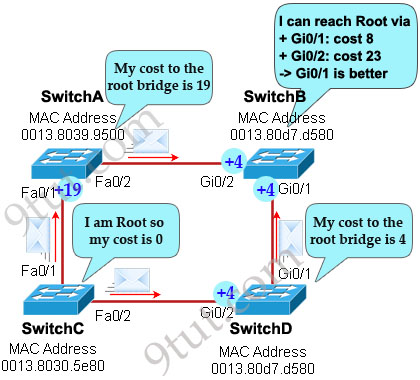
SwitchC advertises its cost to the root bridge with a value of 0. Switch D adds 4 (the cost value of 1Gbps link) and advertises this value (4) to SwitchB. SwitchB adds another 4 and learns that it can reach SwitchC via Gi0/1 port with a total cost of 8. The same process happens for SwitchA and SwitchB learns that it can reach SwitchC via Gi0/2 with a total cost of 23 -> Switch B chooses Gi0/1 as its root port -> D is not correct.
Now our last task is to identify the port roles of the ports between SwitchA & SwitchB. It is rather easy as the MAC address of SwitchA is lower than that of SwitchB so Fa0/2 of SwitchA will be designated port while Gi0/2 of SwitchB will be alternative port -> A is correct but C is not correct.
Below summaries all the port roles of these switches:

+ DP: Designated Port (forwarding state)
+ RP: Root Port (forwarding state)
+ AP: Alternative Port (blocking state)
Question 9
Refer to the exhibit. At the end of an RSTP election process, which access layer switch port will assume the discarding role?
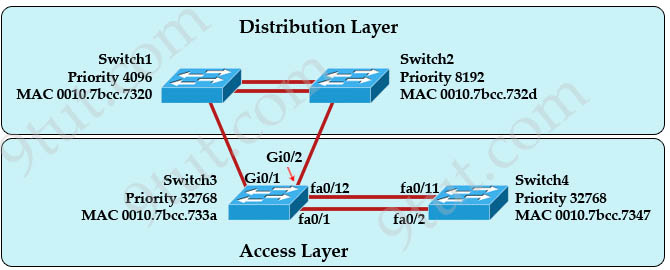
A. Switch3, port fa0/1
B. Switch3, port fa0/12
C. Switch4, port fa0/11
D. Switch4, port fa0/2
E. Switch3, port Gi0/1
Answer: C
Explanation
In this question, we only care about the Access Layer switches (Switch3 & 4). Switch 3 has a lower bridge ID than Switch 4 (because the MAC of Switch3 is smaller than that of Switch4) so both ports of Switch3 will be in forwarding state. The alternative port will surely belong to Switch4.
Switch4 will need to block one of its ports to avoid a bridging loop between the two switches. But how does Switch4 select its blocked port? Well, the answer is based on the BPDUs it receives from Switch3. A BPDU is superior than another if it has:
1. A lower Root Bridge ID
2. A lower path cost to the Root
3. A lower Sending Bridge ID
4. A lower Sending Port ID
These four parameters are examined in order. In this specific case, all the BPDUs sent by Sswitch3 have the same Root Bridge ID, the same path cost to the Root and the same Sending Bridge ID. The only parameter left to select the best one is the Sending Port ID (Port ID = port priority + port index). In this case the port priorities are equal because they use the default value, so Switch4 will compare port index values, which are unique to each port on the switch, and because Fa0/12 is inferior to Fa0/1, Switch4 will select the port connected with Fa0/1 (of Switch3) as its root port and block the other port -> Port fa0/11 of Switch4 will be blocked (discarding role).
If you are still not sure about this question, please read my RSTP tutorial.



Question 7 and Question 9 were in Today’s Exam. Scored 100%
Hello Guys I hope you will be fine there.Now New CCNA (200-120) and CCNA security (640-554) Vouchers on special discount of 58% for World wide, with six months expiry date till you purchase. Each voucher cost 70USD.
Details Required For CCNA Voucher For Discount Processing:
1-Full Name. 1st Name & Last Name (as you want to appear on certificate & documents)
2-Country.
3-City.
4-State.
5-Pin Code (or Area Code)
6-Residential Address (or where you can collect your Certificate or further correspondence
can be received)
7-Date of birth
Add me on Skype through this information which is written below:
Skype Name: rockon660
you can also email me at this email address which is written below:
madeelqaiser@gmail.com
If you have any Questions feel free to contact me.
Thanks,
Best regards,
Adeel
Some thoughts regarding question 4:
by default, the switch will show “spanning tree enabled protocol IEEE” when the “show spanning-tree” command is issued. When configuring spanning-tree modes, the two choices are “pvst” and ” Rapid-pvst”. If you choose PVST , the above referenced show command will still be the same. However, if you choose Rapid-pvst the show command will report ” spanning tree enabled protocol rspt”. My point is that IEEE 802.1W includes both PVST and RSTP, so technically in the question, VLAN 20 is running the PVSTP therefore “B” would also be correct . Any thoughts on this question?
Cant Be sure about the answer. Switch 3 Gi 0/2 port can also be in discarding state and Fa0/11 on S4 might not be in discarding state.
If the links between Switch 3 and Switch 4 are configured as a Ether Channel. Then none of the port on either switch will be in discarding state
Switch 1 is the root switch because of its priority.
Cases Assuming the links between S1 and S2 are gigabit links:
1) If link between switch 1 and switch 2 is configured as Ether Channel: Then PortChannel on switch 1 would be DP and PortChannel on Switch 2 will be RP. Both the ports on each state are in
forwarding state. Gi0/1 on Switch 1 will be the root port because of lower cost path to the root(4) than Gi 0/2 (4 + cost of whatever speed is used between S1 and S2). Now the LAN segment between S3 and S2 needs a DP. S2 port will become DP because it has equal or lower cost to reach the root. If equal cost then it has a lower bridge ID. Therefore Gi-0/2 will be in discarding state
2)If link between switch 1 and switch 2 is NOT configured as Ether Channel: Then one of the port on switch 2 will be RP. And one port will be in discarding state.Gi0/1 on Switch 1 will be the root port because of lower cost path to the root(4) than Gi 0/2 (4 + cost of whatever speed is used between S1 and S2). Now the LAN segment between S3 and S2 needs a DP. S2 port will become DP because it has equal or lower cost to reach the root. If equal cost then it has a lower bridge ID. Therefore Gi-0/2 will be in discarding state.
Therefore irrespective of the fact that Ether channel is configured between S1 and S2 the Gi0/2 wil be in discarding state of links between S1 and S2 are Gig links.
Just to add I was talking about Question 9 :P
Can any one give explanation on the answers to question number 8, I thought switch C was the root bridge because it has the lowest Bridge ID since they all use the default priority no. and switch C has the lowest MAC address.. how come that switch A became the root bridge?
@ CONFUSED: bridge priority is default on all switches in the exhibit, but Switch C has the lower MAC value so it is elected as the root bridge. Switch A is a non-root bridge and has two ports that have the RSTP port roles as ROOT port and DESIGNATED port. Switch A’s root port is Fa0/1 because it has the lowest root path cost to the root bridge(Switch C). Switch A’s designated port is Fa0/2 and rx/fwd frames as needed to the root bridge. Switch D’s root port is Gi0/2 because it has the lowest root path cost to the root bridge (Switch C) as well. Root path cost is determined by Ethernet speed of port.
Speed Cost
10Mbps 100
100Mbps 19
1Gbps 4
Switch A path costs:
Fa0/1: 0+19=19
Fa0/2: 19+4+4+4+4+0=35
@SnP, thanks for the explanation it helped a lot..
can anybody explain me Q.9…..thanx
Q.8 What about answer C? Gi0/2 should be the root port for Switch B.
Also, am i wrong or RSPT doesn’t come up for the 200-120?
Q.8 I think C is correct.
thankx
in Q 8 (B C F are True!) i think:D
any one agree?
@Amir in Q8 A,B,C F are correct
Tarun, q9 is correct , there is no but, switch 3 gi0/2 does not appear inthe answers and as you can clearly see the is no etherchannel , nor is it specified anywhere that there is one…
the explanation on Q9 is very confusing >>and because Fa0/12 is inferior to Fa0/1<<<< ????
I agree with you Gasy. I think it would be “and because Fa0/12 is inferior to Fa0/1″, and then the explanation will be well.
Sorry : it would be “and because Fa0/1 is inferior to Fa0/12″, and then the explanation will be well.
@papshango and @ Snp
for Q8: the cost of fa 0/2 of SwitchA for root bridge is 0+4+4+4+4+19=35 and the same thing from Gi0/2 from SwitchB is 0+4+19=23 so C is the correct answer! how come A???? reply!!!!!!!!!
Hi,
Both websites didn’t working it had shown me “The Connection has timed out”.
https://lms.certnetworks.com
http://www.certnetworks.com
Regards,
Brahmanand
Q8 i am not clear. Can anyone please explain the answer please.
Q8 …. confused from answer A !!!!!!!!!!!!! any explanation !!!!!!!!!!!
@Mohammad Enayet Karim, @sasa: We added the explanation to Q8!
Question on Question 8!
Why is the AP on Switch B and not Switch A? I was under the impression that before using Bridge ID a Designated Port would be selected on best cost to Root Bridge? The would mean Gi0/2 being Designated on Switch B?
Cheers
Paul
Hi, can anyone ps email me info on how to get the latest VCE 3.4.2 crack version or the version that can open recent dumps.
My email address is: mehdi01912330796@gmail.com
Thanks.
Q5 was in today’s exam.
gigabit ports have default cost of 4 but when they are connected to fastethernet ports they run at 100mbps therefore their cost becomes 19. In Q8 SwitchA ‘s f0/2 becomes designated port because switchA had root cost of 19 which is less than SwitchB’s 23 root cost. Mac-address would have come into account if the root cost would have tied.
now here we have a problem . in Q8 switch B gi0/2 is non designated because he is further away from the root bridge than switch A, if you would issue show spanning tree vlan 1 , you would see he is closer BUT that connection Switch C f0/2 — switch D gi0/2 confuses the spanning tree , Switch b sees a gi connection and uses cost 4 , but in reality that connection remains at fastethernet, and in reality that conecion does not have a cost of 4 but one of 19, thus 4+19 = 23. OK i know this is confusing as hell.
If you guys want to see exactly what i mean by this make your own setup in packet tracer or GNS3. do it exactly like the one in the question, put the lower BID at switch C, and you will get the same result, now make the Switch C Switch D connection GI-GI and you will see that witch B gi0/2 will turn designated.
I cleared 200-120
Question 4 & 8 in today’s exam
Almost all questions from 9tut
Thanks everyone :)
Does anyone have ICND2 new book PDF which the text is not rambled and has the original format ? Mine is in a way that text covers all the page and topics are in very small fonts ! please send link of download if you have to amir.r.mousavi@gmail.com
Many thanks
in Q8, the true justification for Switch A’s port becoming DP versus Switch B’s port is that Switch A is cloer to root than Switch B, in the explanation, bridge Id’s r compared when in fact, the order is as follows:
1. Loswet cost
2. lowest Bridge Id
3. lowest POrt priority (128.port identifier)
Tell me if i m wrong!
the Q8 the answer are Correct, but the explanation are wrong the cost in aech port dont matter, in fact when two switch are connect one side with Fastethernet and the other side with gigaethernet, the connection between these 2 switch run on fastethernet, its crazy the explanation about the cost on each port. only in this question is importan the lower bridge ID on each switch, with that, you can see which is the root bridge and the non-root bridge, and you can determinate the root port, the designated port. is just only that. please @9tut remove all stuff about the cost, in this case are not relevant.
@Akshay Saxena
I did the election for designated ports the same way you did. Cost always comes first. If the costs are the same then routers compare bridge ID (MAC).
@Anonymous: Cost does matter – if you look closely, link between switches B and D is gigabit.
Hellp meee
@el diablo en el ojo
In fact, after lowest cost, the bridge id of the upstream bridges r compared n not id of the two bridges itself, then comes lowest port priority number!
@I am lost.
What helo do u want?
@Akshay Saxena: hmmmm one of us is wrong. :) Upstream switches’ BID are compared when electing root port, but when electing designated port between two switches, they compare they own BID.
Anyway, passed today, 98X. :)
@Anonymous
SO what were the out of dump questoins u got?
Hello. can anyone send me the latest dump on ccna. my exams is on tuesday 8 Apr.
My email is : ashvin.007@hotmail.com
Hello,
can anyone send the latest dump on ICND2 ?i am going for it on 22nd Apr.
thanks.
my email is sami.dsami@gmail.com
Refer to Q8 on option A :
The link between SW A and B is not Gigi as SW A port is Fast eth port with 100 meg speed so link speed would be 100 meg not 1 Gig.The path cost if of link not what as port of the switch.There is only one Gigi link between Sw B and D.
Thats why option A is correct.
Refer Q#8 – FINAL ELECTION OF DESIGNATED PORTS BETWEEN SWTICH A & B (Rule Designated port is one/segment, deisgnated port election takes place just like root port election, first of all path cost, then lowest bridge id then lowest port )
Which of the switch A or B will have designated port, it depends upon first criteria above that is the path cost. Switch A reaches Root via cost=19 but Switch B reaches Root with cost 19+19=38 (We are talking about Path cost, one port is Fa and other PORT is Gig so the link speed will be 100meg so cost=19 from Switch B to Switch A)
HENCE SWITCH A WINS THE ELECTION AND IT GOT ITS PORT DESIGNATED that is FA 0/2 while SWITCH B WILL HAVE AN BLOCKED PORT AP
Q0 is confusing for me. I think Switch 4 must have a root port. So fa0/11 on S4 is the root port and consequently fa0/12 on S3 is DP. fa0/2 on S4 is in discarding state (as a backup port)
I meant Q9
@Saz :HI saz by considering switch3 and switch4…. switch3 has lowest BID (that it has lowest mac address)… so we have to consider only the highest port number from switch3 that is fa0/12.
the highest port no fa0/12 switch3′s opposite side is connected to fa0/11 of the switch4 so this fa0/11 will be blocked… only we hav to see highest port no of swith3 then opposite port will be blocked.
so fa0/12 is DP
fa0/1 is DP
fa0/2 is RP
fa0/11 is BLK.
Q4,8 and 9 were in test today
any explanations on Q4 plz ?? why the answer is not C !
Sarah, for Q4, remember top part of output with label Root ID… is info on root switch; under it the part labeled Bridge ID… is info on local switch. Now here is explan again why C is wrong answer: 0017.596d.1580 is the MAC address of this switch, not of the root bridge. The MAC address of the root bridge is 0017.596d.2a00 -> C is not correct.
friends someone bought the voucher for the ccna precentar who can recommend me and tell me if it is true that the discount
which offers voucher adeel someone called me report
The Q8 answer is Correct BUT the explanation is wrong.
SwitchC Fa0/2 and SwitchD Gi0/2 is an 100Mbit link (not 1Gbps) so SwitchD adds +19 (not +4).
The same thing between SwitchA and SwitchB (100 Mbit link).
This is the correct schema: http://i.imgur.com/agJfsf5.png
@Admin: hello admin, answer for the Q6 is “learning and forwarding” that is option B and D.
Which two states are the port states when RSTP has converged? (choose two)
A. blocking
B. learning
C. disabled
D. forwarding
E. listening